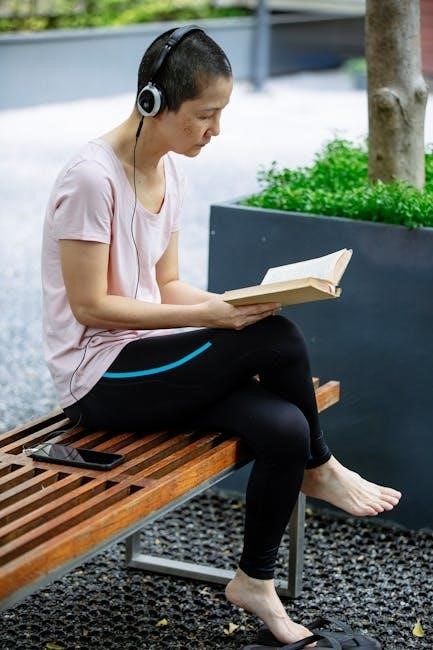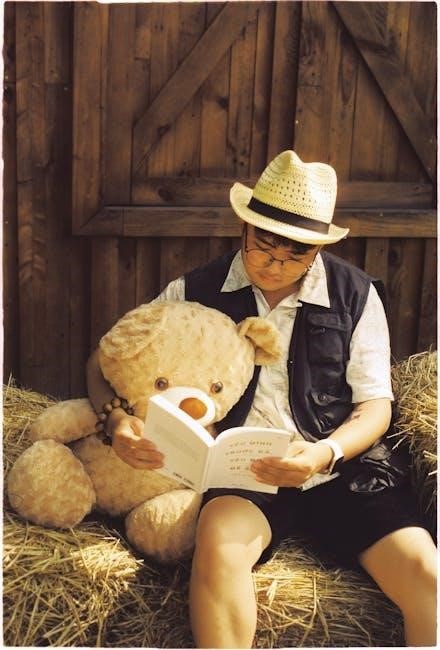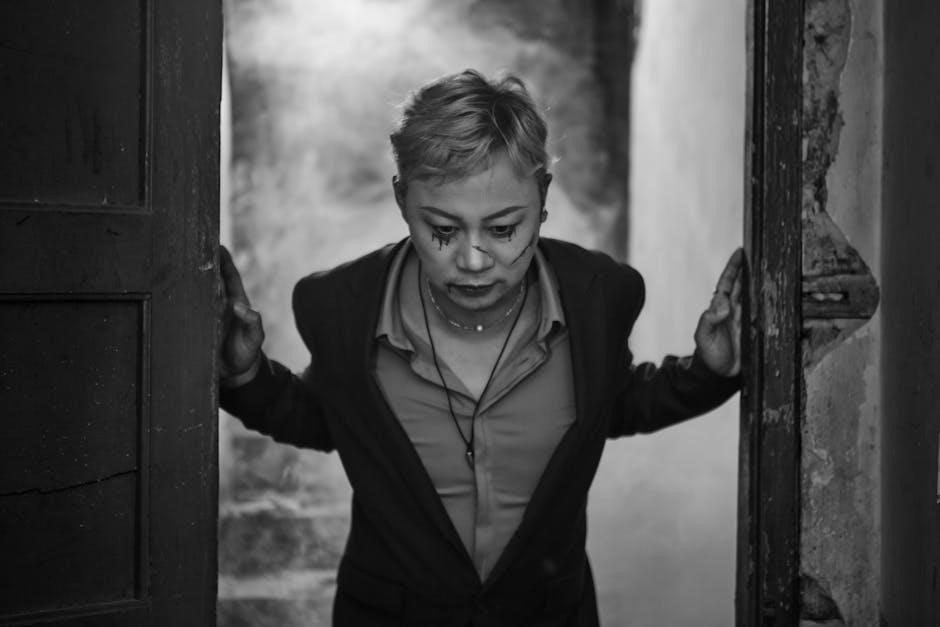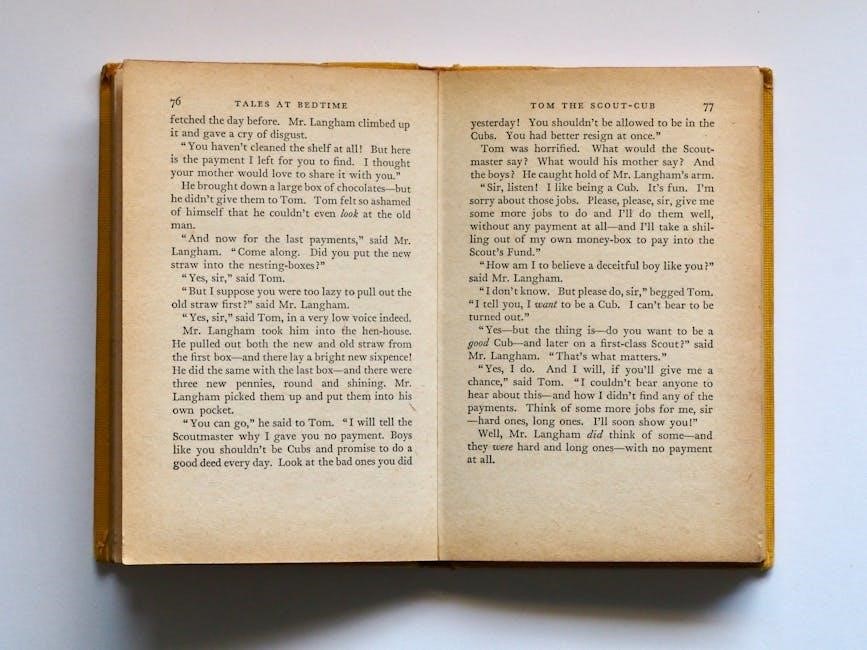John Updike’s “A&P” is a celebrated short story from his 1961 collection Pigeon Feathers and Other Stories, exploring themes of rebellion and social class through Sammy’s perspective as a young cashier infatuated with three girls in bathing suits, sparking a poignant reflection on societal norms and individuality.
Overview of the Short Story
John Updike’s “A&P” is a poignant short story from his 1962 collection Pigeon Feathers and Other Stories. Set in a small-town grocery store, the narrative follows Sammy, a young cashier, as he becomes captivated by three girls in bathing suits who enter the store. Their presence disrupts the mundane routine, leading Sammy to a moment of rebellion and self-discovery. The story explores themes of individuality, social conformity, and the complexities of youth, offering a vivid snapshot of 1960s American life and culture.

Publication and Historical Context
John Updike’s “A&P” was first published in The New Yorker in 1961 and later included in his collection Pigeon Feathers and Other Stories in 1962. The story reflects the societal shifts of the early 1960s, capturing the tensions between traditional values and emerging youth culture. Set against the backdrop of postwar America, “A&P” offers a nuanced portrayal of small-town life, exploring themes of rebellion, social class, and individuality. Its publication marked a significant moment in Updike’s career, solidifying his reputation as a master of contemporary American fiction.

Plot Summary of “A&P”
S Sammy, a young cashier, becomes infatuated with three girls in bathing suits who enter the A&P store, leading to a confrontation with the store manager and Sammy’s impulsive decision to quit his job.
Setting and Main Characters
The story is set in a 1960s A&P grocery store, a typical suburban setting where Sammy, the protagonist and narrator, works as a cashier. The main characters include Sammy, whose rebellious and observant nature drives the narrative, and three young girls who enter the store wearing bathing suits. The leader of the girls, described as having “tanned skin,” captivates Sammy. Additionally, Lengel, the store manager, represents authority and traditional values, contrasting with Sammy’s desire for change and individuality.
Key Events and Conflict
The conflict arises when three girls in bathing suits enter the A&P, drawing Sammy’s admiration. Their unconventional attire disrupts the store’s routine, leading to a confrontation with Lengel, the manager, who reprimands them for not adhering to the store’s dress code. Sammy, feeling empathetic and rebellious, quits his job in solidarity with the girls, symbolizing his rejection of societal norms. This pivotal moment highlights Sammy’s internal struggle between conformity and individuality, setting the tone for the story’s exploration of youthful defiance and self-discovery.

Themes in “A&P”
Themes include rebellion against societal norms, individuality, and the tension between social class and morality, as Sammy’s actions reflect his struggle with conformity and youthful defiance.
Rebellion and Individuality
Sammy’s decision to quit his job symbolizes a rebellion against the oppressive societal norms he observes. His infatuation with the girls in bathing suits sparks a desire for individuality, as he seeks to break free from the monotony of his job and the rigid expectations of his community. This act of defiance, though impulsive, highlights his struggle for self-expression and autonomy in a world that values conformity. His actions reflect the universal human desire to challenge authority and forge one’s own path, even if it leads to uncertainty.

Social Class and Morality
The story critiques social class through Sammy’s observations of the store’s patrons and the girls’ defiance of traditional morality. The girls’ bathing suits symbolize a rebellion against middle-class norms, while Sammy’s working-class perspective highlights the tension between economic status and social expectations. The manager’s reprimand of the girls underscores the moral judgment imposed by societal structures, revealing how class influences perceptions of right and wrong. Updike’s portrayal challenges readers to reflect on how class shapes moral standards and personal identity.

Character Analysis
Sammy, the protagonist, is a young cashier whose fascination with three girls in bathing suits drives the narrative. His internal conflict reflects his desire for individuality and rebellion against societal norms, while the girls symbolize freedom and nonconformity, challenging the conventional morality of their community.
Sammy: The Protagonist’s Motivations
Sammy, the protagonist, is driven by a mix of rebellion and romantic fascination. His impulsive decision to quit his job stems from a desire to break free from the monotony of his routine and assert his individuality. The arrival of the three girls in bathing suits sparks his admiration and frustration, symbolizing his longing for something beyond his mundane life. Sammy’s actions are motivated by a deeper need to challenge societal norms and seek connection, even if it means uncertain consequences.
The Role of the Three Girls
The three girls in bathing suits embody rebellion and freedom, challenging the conservative norms of the grocery store. Their entrance sparks Sammy’s fascination and admiration, particularly for Queenie, who symbolizes confidence and defiance. Their presence disrupts the routine, inspiring Sammy’s impulsive decision to quit his job. The girls represent a desire for something beyond the mundane, influencing Sammy’s quest for individuality and his rejection of societal expectations, even if their true identities remain elusive and idealized in his mind.

Symbolism and Literary Devices
The grocery store symbolizes societal confinement, while the girls’ bathing suits represent rebellion against conservative norms. Updike uses vivid imagery and subtle dialogue to explore themes of individuality and class, creating a layered narrative that invites deeper interpretation of the characters’ motivations and the setting’s significance.
The Grocery Store as a Symbol
The grocery store in A&P serves as a symbol of societal routine and conformity. It represents the monotony of daily life, where individuals like Sammy are trapped in repetitive roles. The store’s fluorescent lighting and structured layout emphasize the artificiality and order of modern life, contrasting with the natural rebellion of the girls in bathing suits. This setting underscores themes of individuality versus societal expectations, making the store a pivotal backdrop for Sammy’s transformative experience and his growing awareness of the world beyond his mundane job.
The Significance of Bathing Suits
The bathing suits worn by the three girls in A&P symbolize rebellion and freedom, challenging the conservative norms of the grocery store environment. They represent a departure from the mundane routines of the store, embodying a carefree and youthful spirit that captivates Sammy. The suits also serve as a catalyst for Sammy’s transformation, prompting him to question authority and societal expectations. Their presence highlights the tension between individuality and conformity, making the bathing suits a powerful symbol of defiance and self-expression in the story.

Discussion Questions and Analysis
What motivates Sammy to quit his job? How does his perspective on the girls evolve? What does the story reveal about societal expectations and individual rebellion?
Study Questions for Readers
Why does Sammy decide to quit his job, and what does this reveal about his character?
How do the three girls symbolize rebellion or nonconformity in the story?
What role does the setting of the grocery store play in shaping the narrative?
How does Sammy’s perception of the girls change throughout the story?
What commentary does Updike offer on social class and morality through the characters?
What significance does the bathing suit hold as a symbol in the story?
How does Sammy’s internal monologue influence the reader’s understanding of his motivations?
What message do you think Updike is conveying about youthful rebellion and its consequences?
Critical Perspectives on the Story
Critics often praise “A&P” for its nuanced exploration of youthful rebellion and societal norms. Sammy’s motivations are debated, with some viewing his actions as a romantic gesture, while others see them as impulsive and self-centered. The story’s focus on class distinctions and moral judgment highlights Updike’s keen observation of American culture. The narrative voice and Sammy’s internal monologue are celebrated for their authenticity, offering a relatable yet flawed protagonist. The story’s ending, particularly, sparks discussion on the consequences of impulsive decisions and the loss of innocence in a rigid social framework.

John Updike’s “A&P” remains a timeless tale exploring societal norms, individuality, and youthful rebellion, leaving a lasting impact on American literature with its nuanced storytelling and relatable themes.
The Legacy of “A&P” in American Literature
John Updike’s “A&P” has left an indelible mark on American literature, celebrated for its nuanced exploration of rebellion, social class, and coming-of-age themes. Its relatable protagonist, Sammy, and vivid setting resonate with readers, making it a staple in academic curricula and literary anthologies. The story’s ability to capture the essence of youthful disillusionment and societal critique ensures its enduring relevance, solidifying Updike’s place as a master of 20th-century American storytelling.
Final Thoughts on the Story’s Impact
John Updike’s “A&P” remains a timeless exploration of youthful rebellion, societal expectations, and personal identity. Its concise yet profound narrative continues to resonate with readers, inviting reflection on conformity and individuality. The story’s ability to provoke thought about morality, class, and self-discovery ensures its lasting impact, making it a cornerstone of American literary studies and a focal point for discussions on adolescence and cultural change.

